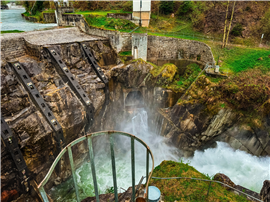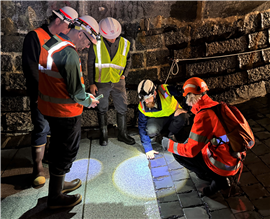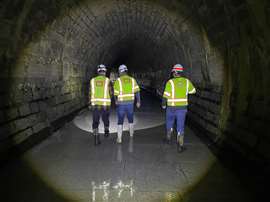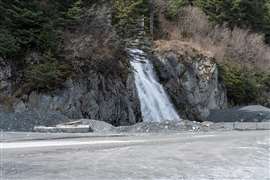US Army engineers visit Switzerland to prep for project
27 August 2024
The US Army is finding that sometimes the best help comes from far away places, as a team of its engineers recently joined Swiss researchers in the Alps in preparation for a dam-and-tunnel project in Alaska, US.
 The Pfaffensprung sediment bypass tunnel, visible from above the dam and the outlet, in Uri, Switzerland. This infrastructure has been in use for over 100 years and continues to provide flood protection and hydropower for the surrounding communities. (Image: Carly Lynch, USACE – Alaska District)
The Pfaffensprung sediment bypass tunnel, visible from above the dam and the outlet, in Uri, Switzerland. This infrastructure has been in use for over 100 years and continues to provide flood protection and hydropower for the surrounding communities. (Image: Carly Lynch, USACE – Alaska District)
Members of US Army Corps of Engineers (USACE) from three regional districts visited a remote hydropower dam in the Alpine canton in Uri, Switzerland, to conduct preliminary research for an upcoming infrastructure project near Seward, Alaska: the Lowell Creek Flood Diversion (LCFD) project.
“Staff from the [USACE] Alaska District, Seattle District and Omaha District toured the inner workings of the Pfaffensprung sediment bypass tunnel, which is part of a dam that impounds the River Reuss,” explained the US Army. “This system has been in use for over 100 years and has employed granite pavers in the lining of its tunnel for the entirety of its existence.
“Over the decades, Swiss engineers at the site have replaced and repaired the pavers at this site, which have also included steel liner and basalt as the material of choice.”
The US team also toured a sediment bypass tunnel at Solis Dam near the canton of Grisons.
What were US Army engineers doing in Switzerland?
 The group observes the transition between the granite and basalt at the Pfaffensprung sediment bypass tunnel. Researchers at the Swiss research university used test sections to observe different materials in the same environment and compare their performance in a real-world setting. (Image: Carly Lynch, USACE – Alaska District)
The group observes the transition between the granite and basalt at the Pfaffensprung sediment bypass tunnel. Researchers at the Swiss research university used test sections to observe different materials in the same environment and compare their performance in a real-world setting. (Image: Carly Lynch, USACE – Alaska District)
The Uri locale (in the “heart of the rugged Swiss Alps,” the US Army said) was selected for its climate and geographical similarities to the US-based project, which is in a subrange of the Boundary Ranges in North America.
But most important was the locations’ use of sediment bypass tunnels.
Coleman Chalup, geotechnical engineer and technical lead for the LCFD project, said, “There are not many places in the world that employ sediment bypass tunnels in their dam infrastructure. It’s a method that occupies an important role where it is used, but they are not common.”
Sediment bypass tunnels are most common on dams that encounter debris, such as glacial silt, a common material in many Alaskan waters. “In the event of a large flood at a protective dam, tunnels at the site prevent a buildup of material that can threaten the dam and the community of Seward below,” said the Army, adding “in the case of a dam such as Lowell, that primarily exists to divert water, a buildup of materials could be catastrophic.”
The Army added that, “These tunnels allow sediment and other debris, such as trees, to pass freely through the infrastructure. These elements act as a ‘safety valve’ for some dams to discharge buildup of material behind them and maintain their storage capacity.”
The USACE suggested building additional safety valves can aid the longevity of the Lowell Dam.
The Army engineers also met with researchers at ETH Zurich, a Swiss university, who are studying abrasion of the Pfaffensprung and Solis tunnels.
“The researchers placed test sections of granite, basalt, high strength concrete and others to observe their performance in a real-world environment,” said the Army.
Investigating granite pavers for the US Army Lowell Dam project
 USACE staff investigate the Pfaffensprung sediment bypass tunnel in Switzerland. (Image: Jesse Brown, USACE – Huntington District)
USACE staff investigate the Pfaffensprung sediment bypass tunnel in Switzerland. (Image: Jesse Brown, USACE – Huntington District)
The Army said the engineering plan in Alaska calls for installing new pavers to line existing tunnels. Pavers would also be included in the new tunnel.
“Typically composed of a high-strength concrete or stone, these large blocks perform very differently based upon their material,” said the Army.
The Swiss tunnels used granite, steel liner and basalt as part of paver reconstruction.
The Army engineers came away interested the most in granite as a potential paver material.
“The use of granite pavers in the sediment bypass tunnels was a particular area of interest for the visiting USACE team who are considering them for the Lowell project,” the Army said. “Compared to other materials, granite is more resilient as the lining material of a sediment bypass tunnel.”
What is the Lowell Creek Flood Diversion project?
 A constructed waterfall outflow of Lowell Creek at Lowell Point Road in Seward, Alaksa, US. (Image: Adobe Stock)
A constructed waterfall outflow of Lowell Creek at Lowell Point Road in Seward, Alaksa, US. (Image: Adobe Stock)
In simplest terms, the LCFD scheme seeks to install infrastructure that will reduce flooding to the municipality of Seward, Alaska. The existing dam-and-tunnel system, the Army said, need safety and efficiency improvements.
“As the first flood control project constructed by USACE in Alaska, the existing dam and attached tunnel reside in the mountains above Seward. In the event of an inundation of water, the dam diverts the surging Lowell Creek away from the community through a tunnel in the mountain and into Resurrection Bay,” said the Army.
“While the tunnel and dam have served the area well, improvements are needed.”
To alleviate some of the burden and increase protections on current infrastructure, the district is planning to construct a new 18-foot-wide (5.5m-wide) tunnel and refurbish the existing tunnel.
The plans also call for constructing an extension of the existing outfall by 150ft (46m) to carry creek flow and debris over a nearby road and a canopy to protect the tunnel inlet from landslides. Rock excavation and stabilisation at the inlet and outlet portal is also expected.
“This augmentation of the Lowell project will greatly enhance the protection provided to the community of Seward,” said the Army. The project was authorised and funded with US$185 million by the US Congress in early 2022.
An industry day to explain the project to interested contractors was held last month. In the industry day notice, the USACE noted construction contract awards were anticipated in the first quarter of 2027.
A representative of the USACE Alaska Division said, “the project is still in the design phase. If we have full construction funding in the [2026] budget, we anticipate being ready to advertise February 2026 with an award in October 2026. These projections could change, of course.”
STAY CONNECTED



Receive the information you need when you need it through our world-leading magazines, newsletters and daily briefings.
CONNECT WITH THE TEAM








